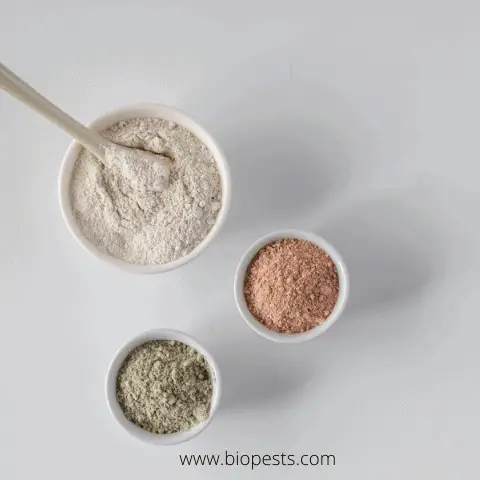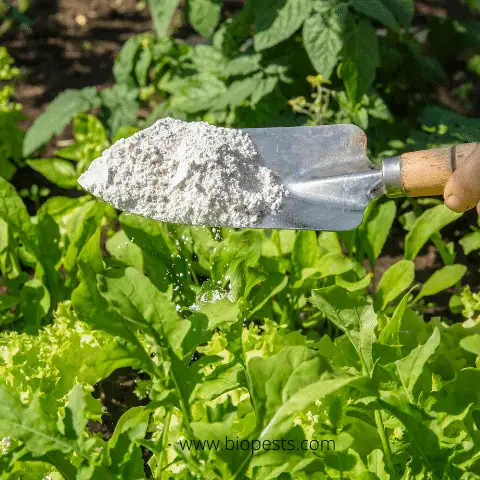The choice of pesticides for our garden is never an easy task. We must first acquire some experience and knowledge of the insects that cause us the greatest problems. Then we must weigh all the circumstances to be able to make the right choice. Lately, I came across two natural products that at first glance seem similar in appearance to each other. Both are used in the garden, but should not be confused with each other. I’m talking about the Diatomaceous Earth and Kaolin clay.
What’s the difference between Diatomaceous Earth and Kaolin clay?
The difference is that Kaolin acts as an insect repellent whereas Diatomaceous Earth acts as an insecticide.
Kaolin clay is composed of a mineral called Kaolinite. When applied to the plants it forms a protective film, preventing the insect from feeding on it and discouraging it from laying eggs. This protective layer does not damage the plant nor does it not alter photosynthesis.
Diatomaceous Earth, also known as D.E. is the fossilized remains of diatoms, a type of hard-shelled protists. It comes in a crumbled white powder. The tiny particles kill the insects within 48 hours by dehydrating them to death. It is usually used in the garden but can be used indoor as well, with caution.
Both Kaolin clay and D.E. are largely considered harmless to people, and a safe alternative to pesticides. Kaolin clay has more a proactive function rather than a reactive.
Let’s try to get further on the subject!
What is Kaolin Clay Repellent?
Kaolin clay is mainly composed of the mineral kaolinite. The name “kaolin” comes from “Gaoling”, a Chinese village located in the southeastern province of Jiangxi. Sometimes it is also referred as “China clay”.
Kaolin is a clay that has numerous uses: in pottery, in the construction industry, in the pharmaceutical field, and even in the food industry. It is possible to use Kaolin clay also as a natural insect repellent.
The product in its purest form is white dust, but the color may change depending on the presence of other minerals: reddish hues, for example, are caused by higher levels of iron oxide deposits, while a green hue is due to decomposed plant matter. In addition to the numerous uses that I have listed above, kaolin can be used as an organic pesticide because it is 100% natural and safe for humans and pets. It is therefore a perfect product for organic farming and family gardens. Moreover, it does not harm honeybees or other beneficial insects.

Kaolin clay is water-soluble and should be sprayed directly on the plants. The product settles on the surfaces of the plant creating a white powdery protective film that acts with double action: it protects the plants and fruits from the heat and sunburn and at the same time it irritates the pests. In fact, the clay hinders their movements and discourages them from laying eggs.
Kaolin clay has also proved effective against some fungi and bacteria that attack plants.
Kaolin clay is particularly suitable for fruit tree culture. In fact, the treatments have a refreshing action that strengthens the leaves from the heat of the sun.
Several studies have claimed that not only does clay protect fruits such as apples or grapes from sunburn, but it has the power to enhance fruit color as well!
How to use kaolin clay as Insect Repellent
As already mentioned, the use and application of the clay is quite simple.
You can prepare the solution yourself by mixing about 3 cups of clay, with a liter of water, and a few drops of Castile soap.
Pour the clay into a dry container and, with the help of a whisk, mix slowly. Gradually add the water and the soap. It is important to follow the instructions and not to mix everything at once because the clay could create lumps and not dissolve properly.
Now that your solution is ready for use, you just have to choose the right sprayer. A backpack sprayer is great for covering large areas, such as an orchard. If, on the other hand, you want to treat only a small portion of the garden or terrace, you can use a spray bottle.
Spray directly onto the plants making sure to cover every part of the plant surface. This will make your plants look dusty and unattractive to pests.
For best results, it is advisable to spray in the early morning or late afternoon, during quiet (preferably cloudy) days. Do not apply the spray on rainy days as it would be wasted.
Although kaolin clay is a natural and harmless product, use a dust mask and safety glasses to protect yourself from inhaling the dust, which would still be unpleasant. (Especially if you have respiratory issues).
How often do you need to apply Kaolin clay?
The clay tends to deteriorate over time, depending on the weather conditions. Then it requires repeating applications. Usually two applications per month are enough.
If you can’t keep up, as a general rule apply the product after you have noticed that your plants no longer have that dusty appearance (for example after rain) or when you see a strong regrowth and new leaves appear.
Against what kind of Pests is kaolin clay most effective?
Studies show that kaolin clay is most effective against:
- Apple maggot
- Colorado potato beetles
- Cucumber beetles
- Grasshoppers
- Leafrollers
- Mites
- Moths
- Thrips
- Psylla
- Flea beetles
- Japanese beetles
- Stink bugs
Now that we covered Kaolin clay, let’s look into Diatomaceous Earth.
What is Diatomaceous earth?
Diatomaceous earth (pronounced: dia-tomay-shus) is mainly known as a purifying supplement for the intestine. Not everyone knows that it is also a valid pesticide for plants and animals. It is 100% natural and does not pose any danger to humans or pets.

Diatomaceous earth is a natural product used in the field of food supplements. It is obtained from the fossil sediments of algae called diatoms, which have existed on earth for millions of years.
It comes in the form of odorless white powder, resembling white flour. It contains about 80%-90% of silica.
Diatomaceous earth also finds great use in the veterinary and botanical fields. It is in fact useful for keeping the most common household parasites under control.
The way this dust kills is through scratches caused by the microscopic edges of the diatoms. The dust scratches the insects and affects their protective shells, called exoskeletons. It absorbs lipids from their waxy outer layers causing them to die of dehydration within a few hours.
How to apply Diatomaceous Earth
The best time to apply Diatomaceous Earth is during the early morning or late evening. Just shake the powder directly on the plants and in their vicinity. It is therefore good to take advantage of the natural humidity, which helps the dust to adhere to the plants.
Diatomaceous earth is not effective on insects when it is wet, but will be effective when dry. D.E. can easily be washed off vegetables before consumption. In addition to the garden, spread it around the area surrounding the garden and around the house and windows.
Diatomaceous earth can work only in dry conditions. Don’t apply D.E. to any area that is consistently damp. Since wet diatomaceous earth will not kill insects. When using it outside, reapply after it rains.
One of the greatest benefits of D.E. is that it kills the bugs physically therefore they can never ever develop immunity against it.
Although it is a natural product, when applying diatomaceous earth, it is important to wear a dust mask so as not to inhale diatomaceous earth dust, as it can irritate the mucous membranes of the nose and mouth. Once the dust settles, however, it doesn’t pose a problem for you or your pets.
How often do you need to apply Diatomaceous Earth?
Once applied, DE will continue to work unless washed or wiped off with wind and rain.
Against what kind of Pests Diatomaceous Earth is most effective?
DE is a non selective insecticide effective against all pests that crawl on plants because contact with the powder is extremely dehydrating. Flying insects like bees are less affected as they don’t come into contact with the substance. D.E. is most effective against:
- Ants and Aphids
- Coddling moth
- Bed bugs
- Slugs and snails
- Beetles and cockroaches
- Worms
- Fleas
- Maggots
- Mites
- Rodends
- Any type of spider
Did you know that you could use DE also as a deodorizer? As a matter of fact, if you have a stinky sandbox (that has been used and abused by your pet) or if you have a pile of compost, you can sprinkle some DE on top in order to neutralize the smell.
Some of the links above are affiliate links, meaning, at no additional cost to you, I will earn a commission if you click through and make a purchase.

